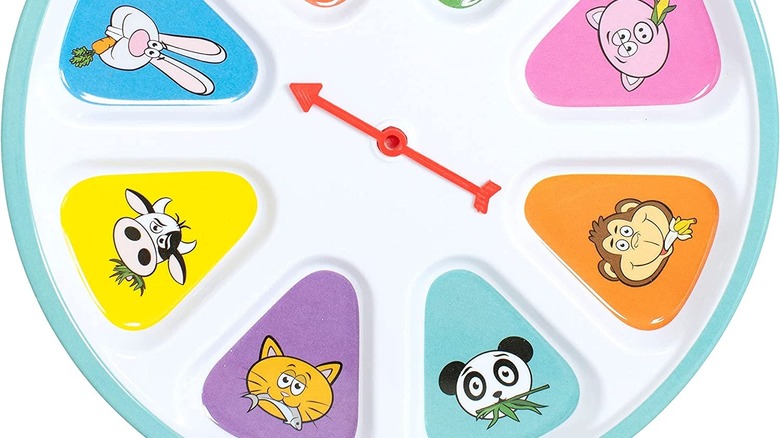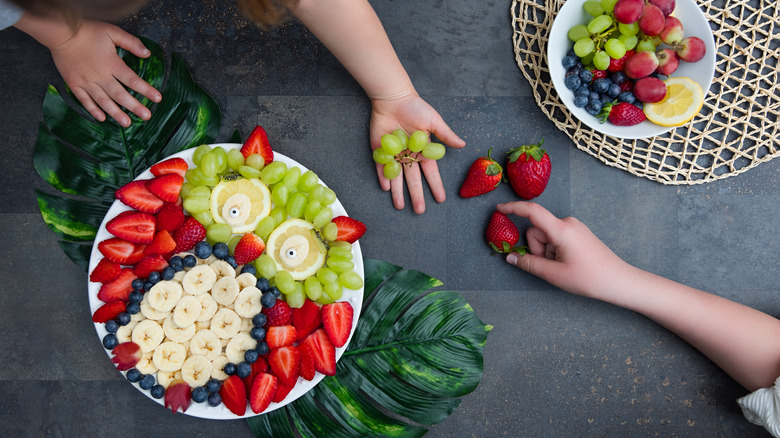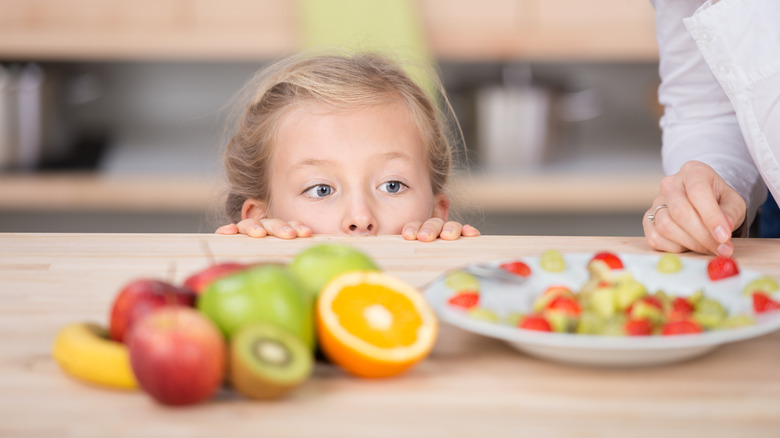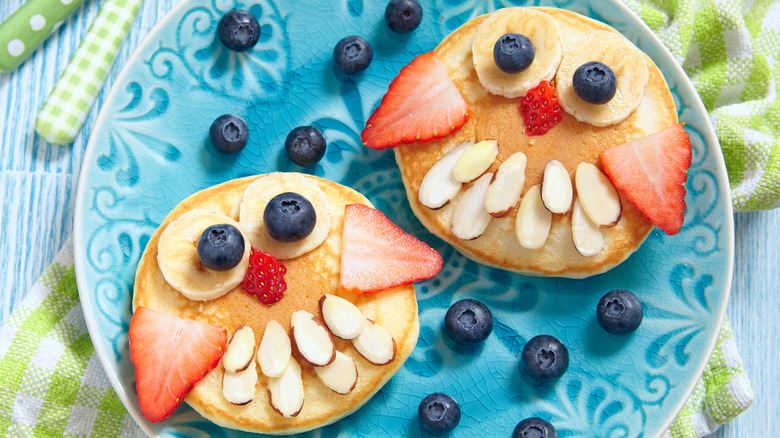12 Easy Ways To Encourage Kids To Try New Foods
We may receive a commission on purchases made from links.
Most parents understand what it's like to contend with what's called a picky eater. They also know that as a grown-up it's up to them to make sure their little one eats a nutritious meal and has an interest in eating a wider culinary range than sprinkles. From dealing with flat refusals to tears and temper tantrums, parents find that the tricky part is how to break through that food barrier and encourage kids to not only try new foods, but also enjoy doing so, and finally to love lots of new flavors. It's good to be aware from the get-go that it's perfectly normal for kids to resist in this way, and a great approach is to communicate with them about why they don't like certain foods or why they're avoiding trying them (via Child Mind Institute).
They may be fixated on only one type of food or feel uptight about some dishes you put in front of them. They may not like the taste, smell, or texture, which is bound to really make them push their plate away. They can also get into the habit of refusing certain foods or maybe just the ones you might be suggesting. If they're slowly introduced, such as by leaving some broccoli on the side, then there may come a day they just grab it and take a bite. Meanwhile, you may want to try some of these easy ways to encourage kids to try new foods.
Give kids an arrow spin meal plate
Grown-ups are always telling children to stop playing with their food, but that doesn't mean that being playful around food isn't a good idea. If you turn trying new foods into a game, then you're going to engage and entertain youngsters enough so that they actually want to eat what's on their plate, even if they haven't tried some of it before. Nutrition is a serious subject, but instead of lecturing about how vegetables are good for you, or trying to persuade youngsters to enjoy different meals, what about using a special Spin Me Plate designed to make mealtimes a fun experience.
As demonstrated on TikTok, the plate has eight areas for separating parts of a meal. So pasta could go in one, fruit in another, and so on. Each of the sections is colorfully designed with cartoon animals, such as a rabbit eating a carrot and a cat eating a fish. All you have to do is fill up some or all of these spots for a toddler. Now let them spin the arrow in the middle of the plate. Whatever it lands on, that's what they eat. Encourage them by saying what it is in a way that sounds enthusiastic. Because they love spinning the arrow, it'll hopefully be just a few spins before they've gobbled up everything.
Interact with foods so kids copy you
Young ones can be reluctant or simply not willing or brave enough to sample a food they've never tried before. A great TikTok tip posted by a mom feeding her toddler involves you interacting with the food first. The idea is that the child watches what you're doing and copies you by taking a bite. Kids love copying, so introducing them to foods through your actions makes sense. You might be surprised to know that kissing the food before you eat it can be helpful. The idea is to make trying new foods a no-pressure, fun situation.
Start by holding the piece of food and bringing it up to your mouth and giving it a kiss. You want to grab their attention, so your actions should be slow and exaggerated, and you can make a sound with your mouth. You might want to do this a few times, and then take turns with the hopefully excited, interested, and hungry child. Let the child get used to the food in a happy way. Change the kiss to a bite and continue in the same way. You should find that kids are eager to do the same as they're so engrossed in the activity and copying you.
Encourage kids to be curious about their taste buds
Ever wondered why kids love sweet flavors so much? If you're questioning whether they're hard-wired to crave candy, then you're right in some ways. It's all about the taste buds, which are not the same when you're born. They change as you grow. Even during teenage years, youngsters still prefer foods that taste sweet when compared with grown-ups, although by this age they'll have hopefully tried a whole different bunch of different dishes and be open to exploring their culinary journey. It's the same reason why kids may push vegetables to the side and not want to try them because they're bitter (via Charlotte Eye Ear Nose and Throat Associates).
Of course, parents need to introduce new foods to promote a healthy diet. Easier said than done, but one TikTok poster reveals that she taught her kids about their taste buds as a way of getting them to try new foods they've rejected in the past. If you've got toddler-aged kids, try it yourself. In front of them, say out loud that you're wondering if your taste buds have changed before taking a bite of a food you want them to try. Take a bite and them comment on what it tastes like. You may say you like it. Or you may state that you don't, but you'll try it again in a couple of weeks. This teaches children to try foods by recognizing that their tastes can and do change.
Serve a platter dinner
It's human nature that if you're not given any choice and are ordered to do something you're not sure about, you may balk and rebel at the idea. Since kids are learning about food and are developing at such a fast rate, giving them choice about what to put on their plate is a great way to introduce foods without creating a stressful environment when it's time for dinner. If you're interesting in mixing and matching, then one tip you may want to add to your repertoire comes from an Aussie mom featured on The Healthy Mummy. What's great about this idea is that it's easy to prepare and a great way of introducing new foods if you have a few mouths to feed.
Instead of serving individual plates with the food already dished out, put a big platter in the middle of the table with different sections for food and let youngsters choose whatever they want from it. Of course, the key to this working well is to add some choices that haven't been tried before. Keep it healthy and balanced too, with plenty of variety. You can add fruit, hard boiled eggs, cheese, and meats, as well as salad ingredients, vegetables, and snacks. While they can grab what they like, let them know that they can only do so if they try something from each section of the platter.
Introduce variations with a taste test
When you dine out, do you ever comment on different dishes and what you like, or don't like, about them? if you're interested in cooking, then you may taste food as you make it, deciding whether the recipe needs more salt or spice added. That's what makes different cuisines so fascinating. By trying new foods, we broaden our culinary horizons and get to know the classics that we love as well. Developing this in children is also a great way to get them interested in trying different foods and variations of a dish they already know. A children's dietician and mom suggest a clever mealtime tip on TikTok with a taste test for kids.
This example uses spaghetti, but you can adapt it how you like. On a plate add three separate small servings of spaghetti noodles. One of the portions is just plain pasta, another has sauce on it, and the third is mixed with butter and Parmesan cheese. It works if the plain food is one that the child is familiar with, so that there is a link to the different varieties. This method is called food chaining. To make this more interesting and engaging, you can ask your little diners which one they like so that trying each one becomes part of an activity. Ask them to tell you if they like it, and if they do, you might want to mix the spaghettis together into one serving.
Take kids grocery shopping for new foods
Doing a grocery shopping trip, especially with a young child in tow, isn't always at the top of the list of fun things to do for parents. As you race down aisles trying to load up on provisions, kids may point and even grab foods they want from shelves. If you're rushing around, you may find it easier to just ignore their pleas for items, such as candy, that you don't want to buy or just keep telling them no. Of course, then there's the risk of a meltdown. And when you get home, you may also have to face a picky eater who doesn't want to try what you've cooked. You might want to rethink how you let kids interact with food way before it's put on their plate. Try getting them involved when you're at the store (via First Things First).
Take the time to involve children in the shopping experience. The more they're involved in the process, the more they may be inclined to try the new foods that they've had a part in picking out. If you're a parent with a toddler, ask them to choose a piece of fruit or a vegetable they've never tried before. Let them touch what they've chosen and help put it in the cart. Even if they'll only try a small amount once it's prepared at home, it's part of their learning curve and gives them a sense of choice and control.
Add sprinkles now and again
Some ways to expand your children's diet may focus on getting them engaged with activities. Others may look at the psychology and a youngster's relationship with different foods, and even mealtimes, and how this can be nurtured and challenged. However, some are simply clever tricks that you can pull out once in a while when you really need to. This Instagram idea definitely falls in the latter camp. Rather than pulling a rabbit out of a hat, you just need to pull some rainbow-colored sprinkles out of the cupboard.
Sometimes you know that if you could just get a child to try a dish, they'd happily wolf it down. It can be super frustrating when they refuse. It's not always easy, for parents and kids alike. Youngsters, for example, might be feeling put out about a side of mashed carrots that's just been placed in front of them. At the same time, grown-ups may have a thousand things to do and feel under pressure to get a meal or snack time under way. When you reach this face-off, add a few sprinkles on top of the food to coax them to at least give what you've made them a try. While you don't want to sugarcoat every new food, a few sprinkles may help make a dish more colorful and tempting from time to time.
Inspire a healthy relationship with food
Healthy eating is more likely if you have a health relationship with food. When kids are young, games and a fun environment can really create positive reinforcement around the dinner table. Interacting with kids as they're eating can also help them take their time and not gobble down dishes. In other words, they're developing a mindful approach. This can be helpful at all ages in terms of how youngsters eat. While toddlers may be exploring new foods, teenagers can also learn how to feel more at ease with different dishes and their diets as well.
Verywell Family suggests that by appreciating food, teens can develop a healthy mindset about it. What this really entails is actually focusing in on mealtimes and what's on the plate. Sitting down to eat, slowing down, and really enjoying each mouthful bring the attention into the here and now. This awareness, in youngsters of various ages, emphasizes how eating food is an experience. Part of this is understanding appetite and feeling more in tune with your body. It's also about having a more open attitude to food in general. Keeping electronics away from the table, teaching table manners, and encouraging good eating habits are all ideas that feed into an overall mindful approach. This is also vital as kids grow older and begin to be influenced by forces beyond their innate sensibilities.
Focus on senses other than taste
If you're ever cast your eye over a splendid-looking buffet table, then you'll recognize that food can be a visual feast. If you've ever felt your mouth water at the aroma of barbecued goodies at a cookout, then you'll know that food is about different odors making you feel hungry. If you've ever gotten excited at the sound of popcorn kernels popping, then you'll know that food is an auditory journey at times, too. If you've ever loved the velvety softness of pasta noodles, then you'll know that food is sometimes about how it feels in your mouth. Eating is not just about taste.
This TikTok tip from a mom trying raw green beans with her 3-year-old suggests that parents involve more senses. Try it out. Take a bite of a fresh bean in front of your child, and talk about the crunchy sound it makes. Ask them whether they can make the same sound with their mouth. If they eagerly try, ask them whether they had the same experience as you with the bean being juicy. You're not simply serving a bean and hoping they taste it. What you're doing is engaging the other senses, which are all part of the eating experience.
Give them control by letting them explore in the kitchen
if you've ever been in the vicinity of a child refusing to eat what's put in front of them, then you'll know it can be unpleasant for all concerned. Think tears, tantrums, and the throwing of spoons, not to mention the tipping up of bowls. No matter how much you may say pretty-please to toddlers and try and cajole them into eating something new, if they don't want to, then the chances are they're not going to. While forcing the issue doesn't work, you may want to rethink your strategy with the help of a TikTok tip and involve them in dinnertime when you're getting their meal ready.
Give your kids an apron, and a chef's hat if you have one, and get them to be part of the preparation of food in the kitchen. If they've already chosen a few items at the grocery store, then they're already invested. Now you can let them handle the food before it reaches the table. Their curiosity will lead them to pick up different ingredients and take a bite. Some of the foods they may know, but you can also make sure that there are foods that are new to them as well. What you're ultimately serving up here is a healthy dish of freedom and the opportunity to explore as well as the power to choose what they want to eat.
Eat new foods first
Plenty of adults are stuck in their ways when it comes to trying different types of cuisines and dishes or even individual new foods. So, it's no surprise that when faced with a world of flavors and tastes they've never encountered before, kids might be a little unconvinced that they want to venture down a road of culinary discovery. Think about the sourness of a lemon or the bitter heat of a bell pepper, and imagine how that first bite might feel. To nudge kids in this direction, you could try a TikTok tip that aims to spark interest.
The key to this trick is not to suggest a little one tries what you want them to try. Instead, sit opposite them at the table when they're already eating and casually put a plate with small pieces of food, such as bits of kiwi fruit, on the table in a way that they're going to notice. Ignore them as you pick a piece up with your fingers and eat it. Kids are naturally curious, so wait for them to ask what you're eating. Answer simply and carry on. If they ask whether you'd like to try their food, then do the same to them, asking if they'd like to try your kiwi. You could also wait for them to ask you themselves. If it's their idea, then they're bound to be happy to take a bite.
Be creative with food art
Children are imaginative and creative, so bringing these concepts to the dining table can really be an effective way to get them to open their minds — and their mouths — to different foods. It can also turn tense mealtimes into a fun experience. Food & Nutrition suggests trying an artistic approach that could also be a great way for parents to connect with their kids. If you're struggling when it's time to eat, then give food art a go.
What you're doing is making a collage on the plate with food. You can even get your child to help. To make a donkey, for example, Food & Nutrition suggests starting with five pancakes, around 6-8 inches across, ensuring one isn't as darkly colored as the others. You'll need an apple, a strawberry, and two blueberries. Cut the lighter pancake into a large oval shape and create 4 smaller ovals from the other pancakes, cutting off an inch and a half from the bottom to create the legs. With the remaining bits of pancake, make two triangular ears and use the lighter one to create a mane and tail. Slice the apple and add as hooves, make circles for the eyes, and cut the strawberry into two triangles for the inner ears. Cut a blueberry in half to make pupils for the eyes, and turn the other one into eyebrows and nostrils. The best part: They get to eat their creation.












